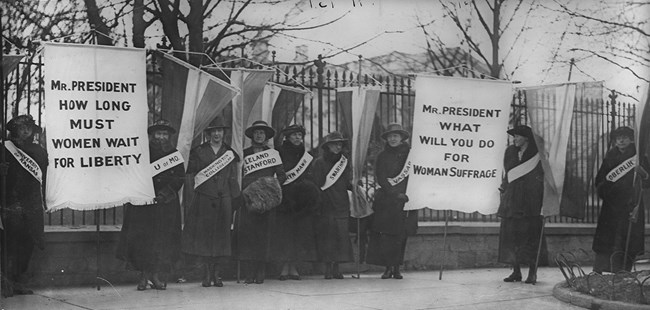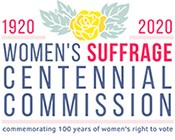Part of a series of articles titled On Their Shoulders: The Radical Stories of Women's Fight for the Vote.
Article
“Failure is Impossible!” The Battle for the Ballot
By Winifred Conkling
Harry T. Burn had a secret. Everyone assumed he was an “anti,” meaning he would vote against ratification of the 19th Amendment granting women the right to vote. After all, the 24-year-old first-term member of the Tennessee House of Representatives was from a conservative district, and he was running for reelection in the fall.
All eyes were on Tennessee. In 1919, the U.S. Congress had passed the suffrage amendment, but before it could become law, three-fourths of the forty-eight states needed to ratify it. By summer 1920, thirty-five states had voted to support it; one more was needed. The Tennessee Senate had approved the measure, so it was up to the Tennessee House of Representatives to make the historic vote.
The legislators gathered on August 18, 1920, a stiflingly hot day, even by Nashville standards. The second-floor galleries of the statehouse were crowded with women and men on both sides of the issue, eager to witness history being made. It appeared that the vote was evenly divided, 48 to 48.
Harry T. Burn had a secret. Everyone assumed he was an “anti,” meaning he would vote against ratification of the 19th Amendment granting women the right to vote. After all, the 24-year-old first-term member of the Tennessee House of Representatives was from a conservative district, and he was running for reelection in the fall.
All eyes were on Tennessee. In 1919, the U.S. Congress had passed the suffrage amendment, but before it could become law, three-fourths of the forty-eight states needed to ratify it. By summer 1920, thirty-five states had voted to support it; one more was needed. The Tennessee Senate had approved the measure, so it was up to the Tennessee House of Representatives to make the historic vote.
The legislators gathered on August 18, 1920, a stiflingly hot day, even by Nashville standards. The second-floor galleries of the statehouse were crowded with women and men on both sides of the issue, eager to witness history being made. It appeared that the vote was evenly divided, 48 to 48.

Defying expectations, Burn voted in favor of women’s suffrage. What he had not shared with anyone was that earlier that morning, he had received a letter from his mother urging him to support ratification. He had the letter in his pocket when he cast his decisive vote, changing the United States Constitution and franchising women across the country.
Women had been fighting for suffrage for 72 years. The organized battle began at the Seneca Falls Convention in 1848 when Elizabeth Cady Stanton pushed to get the issue included at the first women’s rights convention. At the time, women – even free white women -- had few legal rights. When they were young and single, females had to do what their fathers said. When they married, they had to obey their husbands. Legally, a married woman had no identity separate from her husband. She and her husband became one person – and that person was the husband. Some single, adult, free women lived alone, but they were far from the norm.
In the mid-19th century, free married women did not have the right to own property in most states. They could not sign legal documents. They had limited opportunities for paid work, and if a woman had a job, her wages often belonged to her husband or her father. Women could not serve on juries or testify in court. They could not attend most colleges. They could not have custody of their children if they divorced their husbands, no matter the reason. They were expected to remain quiet in public. Most of these strictures on free women’s lives were slowly but progressively being loosened as the nineteenth century progressed. By mid-century, many states had begun to pass married women’s property laws with gradually increasing legal rights granted to women.
With the rise of the industrial revolution, particularly in the Northeast, many factory jobs were open to young women and they were explicitly recruited for these jobs. More than 20 post-secondary institutions of learning for women existed by 1850 and that number continued to climb in the second half of the century. And, of course, women’s primary role was still seen as domestic and private by most; however, women preachers were not unheard of in mid-century America, and women’s collective organizations were everywhere by then, often meeting (separately from men) in public spaces such as hotels. However, there remained one essential marker of free women’s second-class citizenship in mid-century America -- they did not have the right to vote. Of all the injustices suffered by women, Stanton considered suffrage the most important. If women had the right to vote, they would have the power to change the multitude of remaining laws that kept them unequal to men.

The suffragists, many of whom were also abolitionists, voluntarily suspended their efforts during the Civil War, tacitly acknowledging the precedence of the battle to free enslaved people. The campaign for equal rights for formerly enslaved people restarted after the war, led by the American Equal Rights Association, a group of former abolitionists that included supporters of women’s rights. The group debated their support of the 14th and 15th Amendments, questioning whether suffrage should be universal or focus first on voting rights for African-American men.
Stanton and Anthony were tired of being told to be patient. At first, they favored universal suffrage, establishing voting rights for all women and African-American men. When the discussions focused on choosing between groups, they continued their work on female suffrage; in fact, they campaigned against the Fifteenth Amendment, which established voting rights for formerly enslaved men. They opposed the amendment, “Not for what it is, but for what it is not,” Stanton wrote. “Not because it enfranchises black men, but because it does not enfranchise all women, black and white” (Baker, 72). This issue ultimately split the suffrage movement into two groups, one that continued to work for voting rights for women and another that supported African-American male suffrage, with the promise that female suffrage would follow.
Stanton and Anthony wanted women’s suffrage nationwide. Unsurprisingly, after dedicating most of their adult lives to women’s rights, universal women’s suffrage was their priority. On January 10, 1878, Sen. Arlen A. Sargent of California proposed the 16th Amendment to the Constitution, written by Stanton and Anthony, which read: “The right of citizens of the United States to vote shall not be denied or abridged by the United States or any State on account of sex” (Ward and Burns, 155). The amendment was defeated. Instead of a constitutional amendment, the first laws providing for women’s right to vote were passed at the territorial and state levels. At the end of the 19th century, there were only four states – Wyoming (1869), Colorado (1893), Utah (1896), and Idaho (1896) – in which women had won full enfranchisement.
Weary after more than fifty years of women’s rights and suffrage work, Stanton died in 1902. Four years later, Anthony traveled to Washington, D.C. to attend a celebration of her 86th birthday. Anthony walked to the podium to address the crowd of suffrage supporters. She concluded her remarks, which became her last formal statement about suffrage, with the words: “Failure is impossible!” (Sherr, 324) Anthony became sick on her way home to Rochester, New York. As she was dying she said, “I have been striving for over sixty years for a little bit of justice no bigger than that, and yet I must die without obtaining it… It seems so cruel” (Ward and Burns, 212). She died in 1906.
In the early twentieth century, a new wave of activists inherited the leadership of the suffrage movement. These women came up with spirited campaigns, including parades and public protests. On January 10, 1917, twelve women conducted the first pickets outside the White House. They stood silently in front of the White House gates holding banners asking: “MR. PRESIDENT, HOW LONG MUST WOMEN WAIT FOR LIBERTY?”

As the months passed, the jail sentences became longer and the treatment of the women became harsher. By October, Alice Paul and a group of other incarcerated women began a hunger strike. In response, the women were violently force-fed. Paul was moved to a psychiatric ward and denied access to a lawyer.
Still, the women continued their protest. The situation was a public relations nightmare for the White House. By late November, the suffrage prisoners had been released. In January 1918, Wilson changed his position and urged Congress to support suffrage as a war measure. The next day -- exactly one year after the first picketers took their posts outside the gates of the White House -- the House of Representatives passed the suffrage amendment, but it failed to pass in the Senate. The protests continued for another year. Finally, on June 4, 1919, the 19th Amendment passed both houses of Congress. It was then up to three-fourths of the states to ratify it.
By the following spring, thirty-five of the required thirty-six states had ratified the amendment. That’s when the attention shifted to Tennessee. On August 18, 1920 – one hundred years ago -- the members of the Tennessee House of Representative gathered for the vote. When Burn voted for suffrage, he was called a “traitor to manhood’s honor” (Wheeler, 347). He responded by explaining that he voted in favor of the 19th Amendment because he considered suffrage a right, and he thought he had a moral obligation to support it. He said he had a rare opportunity “to free seventeen million women from political slavery” (Monroe, 76). and he was honored that his Republican Party would have the privilege of making national suffrage possible. On a more lighthearted note, he offered one more reason: “I knew that a mother’s advice is always safest for a boy to follow, and my mother wanted me to vote for ratification” (Monroe, 76).

Author Biography
Winifred Conkling is the author of Votes for Women! American Suffragists and the Battle for the Ballot (Algonquin Young Readers, 2018). She is the award-winning author of fiction and nonfiction for young readers.
Bibliography
Baker, Jean H. Sisters: The Lives of America’s Suffragists. New York: Hill and Wang, 2005.
Cohen, Jennie. “The Mother Who Saved Suffrage: Passing the 19th Amendment,” History Stories Series, History.com, last modified April 1, 2019.
Editors, (History.com).“Seneca Falls Convention,” History.com, last modified November 20, 2019.
Griffith, Elizabeth. In Her Own Right: The Life of Elizabeth Cady Stanton. New York: Oxford University Press, 1984.
Monroe, Judy. The Nineteenth Amendment: Women’s Right to Vote. New York: Enslow, 1998.
Sherr, Lynn. Failure is Impossible: Susan B. Anthony in Her Own Words. New York: times Books, 1995.
"The 19th Amendment,” Online Exhibits, National Archives, website, last modified May 16, 2019.
Ward, Geoffroy C. and Ken Burns. Not for Ourselves Alone: The Story of Elizabeth Cady Stanton and Susan B. Anthony. New York: Knopf, 1999.
Wheeler, Marjorie Spruill, ed. One Woman, One Vote: Rediscovering the Woman Suffrage Movement. Troutdale, OR: NewSage Press, 1995; p. 347
Last updated: December 14, 2020
